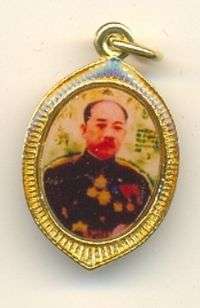Phetsarath Ratanavongsa
| Prince Phetsarath Ratanavongsa | |||||
|---|---|---|---|---|---|
| Uparaja | |||||
| Born |
19 January 1890 Luang Phrabang | ||||
| Died |
14 October 1959 (aged 69) Luang Phrabang | ||||
| Wives |
| ||||
| |||||
| Father | Bounkhong | ||||
| Mother | Thongsy | ||||

Prince Phetsarath Ratanavongsa (Somdej Chao Maha Oupahat Pethsarath Ratanavongsa lit: His Highness (the) Vice-King Phetsarath Ratanavongsa) (Lao: ເພັຊຣາຊ; 19 January 1890 – 14 October 1959) was prime minister of Laos from 1942 to 1945, and was the first and last vice-king of the Kingdom of Laos.
Biography
Early life
Phetsarath was born on 19 January 1890 in Luang Prabang, the second son of Oupahat Bounkhong and his second wife, Princess Thongsy. One of his younger brothers was Souvanna Phouma. Bounkong's eleventh wife was the mother of Souphanouvong. Phetsarath went to study at the colonial Lycee Chasseloup Laubat in Saigon and continued on in 1905 to the Lycée Montaigne and to the École coloniale in Paris. He returned to Laos in 1912, married Princess Nhin Kham Venne in 1913, and started working as an interpreter for his father.
Government service: 1914-1941
In 1914, he became a clerk at the Office of the French governor in Vientiane. Two years later he was promoted to assistant secretary to the French governor. In 1919 he received the title of Somdeth Chao Ratsaphakhinay, a title held by his father and one of the highest ranks in the country. That same year he was named Director of Indigenous Affairs of Laos operating under the French governor.
As the country's last oupahat, he became a leading figure of modern Laos. He established the system of ranks and titles of the civil service, promotion and pension plans, and created a Lao consultative assembly, reorganized the king's Advisory Council. Phetsarath reorganized the administrative system of the Buddhist clergy, and established a system of schools for educating monks in Pali. He created the Institute of Law and Administration to train entry level officers (Samien) who would then move up the ladder as Phouxouei, Chao Meuang, and Chao Khoueng successively. He set up rules to reward, reassign, and promote deserving civil servants, and created the judicial system, including civil and penal codes.
Lao Issara: 1941-1957
Phetsarath played a dominant role in Lao politics before and after the Japanese occupation. He was the leader of the Lao Issara movement. He was the Vice-regent of the Laotian province, beginning in 1941, ascending in prominence under the promises for power from Japan. In 1944 he sent Kathanong Souvannakhily, a brigade officer, to attack Thailand, but he went missing in action. The attack was subsequently halted. From 1941-5, Phetsarath attempted to supplant officials in Laos and Vietnam, but in the regions of Vietnam, the resistance from the local proletariat was too strong.[1]
On 8 April 1945 the King had declared (under Japanese pressure) that Laos was no longer an French protectorate and on 28 August 1945, following Japan's surrender, Phetsarath sent a telegram to all Laotian provincial governors notifying them that the Japanese surrender did not affect Laos' status as independent and warning them to resist any foreign intervention. However Free French forces had already occupied Luang Phrabang and met with the King who assured the French colonials that Laos was still a French protectorate despite the April proclamation. On 10 October, the King dismissed Phetsarath as Prime minister ; ten days later, the Lao Issara provisional assembly proclaimed the deposition of the King and appointed Phetsarath as "Head of State". As the French retook control of Laos, Phetsarath fled in April 1946 to Thailand, where he led the Lao Issara government-in-exile.
Return: 1957-1959
In March 1957, he returned to Vientiane where he received a wild welcome. On 10 April 1957, he travelled to Luang Prabang by car and was received by an enormous crowd of citizens, government officials, and members of the police and the army. On 16 April he paid a courtesy call to King Sisavang Vong and was given back his old title of Oupahat of the Kingdom of Laos. In December 1957 he visited Samneua and Phongsaly where Souphanouvong symbolically offered the return of the Pathet Lao's two regrouping provinces to the Kingdom of Laos.
He was offered an official government residence in Vientiane, but preferred to stay in his villa, Xieng Keo, in Luang Prabang with his Thai consort, Mom Aphiphorn. In early October 1959 the Phoui Sananikone Government decided to use Phetsarath's official residence in Vientiane as the new prime minister's office. They vacated the building and shipped his personal belongings by boat to Luang Prabang, which upset him immensely. On 14 October 1959 Phetsarath was taken ill to the hospital, suffering from a severe brain hemorrhage. A French doctor operated on him, but it was already too late. He never regained conscience and he died at the age of 69.
In part because of his popularity and in part because of his perceived saksit power, many Lao people hang his picture in their homes.
References
- Sila Viravong: Chao Phetcharat - Strong Man of Kingdom of Laos, Thai Translation by Sommai Premjit, Matichon Press, BE 2542 (AD 1999), ISBN 974-321-465-8
- Søren Ivarsson and Christopher E. Goscha: Prince Phetsarath (1890–1959): Nationalism and Royalty in the Making of Modern Laos, Journal of Southeast Asian Studies (2007), 38: 55-81, Cambridge University Press
| Political offices | ||
|---|---|---|
| Preceded by none |
Prime Minister of Laos 1945 |
Succeeded by Phaya Khammao |
| Political offices | ||
|---|---|---|
| Preceded by King Sisavang Vong |
Head of State of Laos 1945-1946 |
Succeeded by King Sisavang Vong |